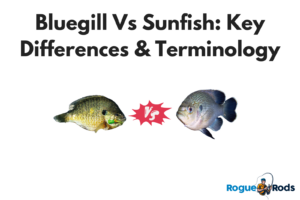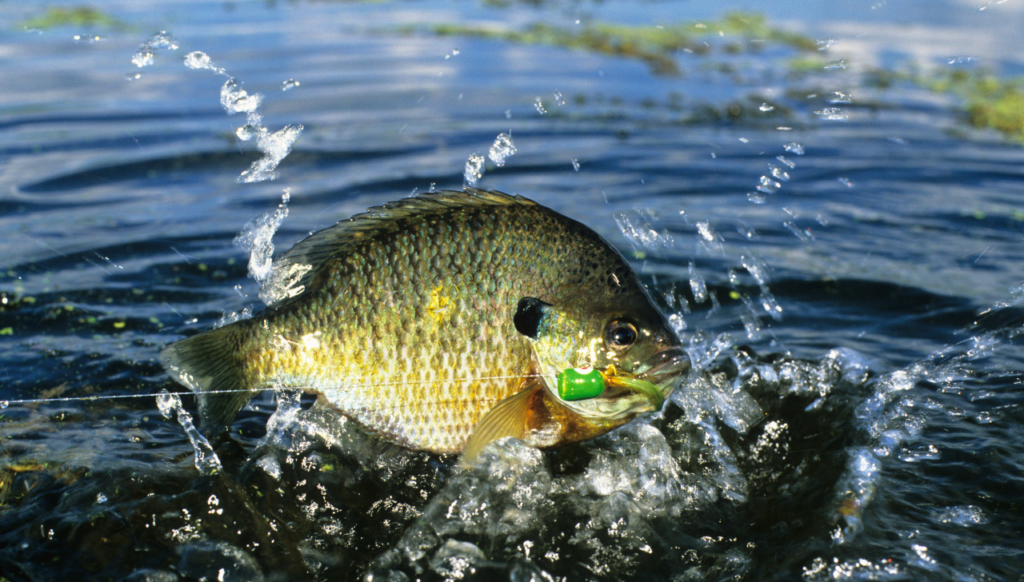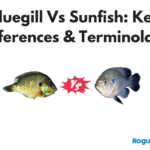As an avid fisherman, you’ve no doubt hooked a bluegill before.
Or… maybe it was a sunfish.
Or maybe both?
What’s the difference between a bluegill and a sunfish anyway? After all, they look the same, right? And to make matters worse, bluegills are a type of sunfish – but not every sunfish is a bluegill.
Add to this the local names of these fish, the different sizes and locations they can appear, and the fact that there are so many sunfish species out there, telling the difference can be a bit of trouble when you’ve reeled one in!
Never fear! In this article, we’ll discuss:
- Where the confusion between Bluegill and Sunfish comes from
- An overview of the Sunfish family
- Distinct differences in the appearance of Bluegill.
By the end, you’ll have no more problems with pointing out your Bluegill. Let’s get to it!
The Confusion
First of all, Bluegills have a lot of different names. “Copper heads”, “breams”, and a range of other names can create the first hurdle.
However, for the sake of clarity, we’re talking about Lepomis macrochirus, which from here on out we will refer to as the bluegill.
Bluegills are panfish, so they’re good eating and are a common species for freshwater anglers.
The problem is that they also look an awful lot like other species of sunfish! Being that they are sunfish themselves, this isn’t such an issue as they are all edible.
However, when trying to tell them apart from their relatives, it can cause a few issues.
This isn’t a problem when distinguishing between something like largemouth bass and bluegill, as they don’t share habitats and the largemouth bass is a significantly larger and more recognizable fish.
Overview of the Sunfish Family
The sunfish family of fish, Centrarchidae, includes a lot of fish familiar to the average angler.
For instance, large and smallmouth bass – some of the most famous freshwater sport fish – are members. The spotted black crappie, the longear sunfish, and the blue-spotted sunfish are all relatives of the bluegill and visually similar at first glance.
Most of the sunfish are between five and 10 inches, and they all look deceptively similar to the bluegill – which makes sense, given they are part of the family!
Sunfish are generally flat across and deep from spine to belly. They love warmer water, and they tend to favor areas with good vegetation cover and plenty of aquatic plants in which to build their nests.
Sunfish are all carnivorous and are voracious hunters of smaller fish and insects. They also all sport different types of camouflage colors and patterns to help disguise them from predator and prey alike.
Everything about Bluegill
You might have guessed the bluegill’s distinctive feature by its name: Blue gills!
While the internal gill isn’t blue, they have a unique flap extending from its gill cover that is bright blue and lends the species its name. Bluegills are some of the smaller sunfish at six to nine inches from nose to tail.
While the color of the bluegill varies from specimen to specimen, they are generally blue to green with vertical stripes running down the length of their bodies. The stripes are darker towards the spine and fade out at the lighter belly.
They have a generally similar shape to other members of the sunfish family, but there are enough distinctions to set them apart if you know what to look for.
The Bluegills Blue Gills
The most distinctive feature of the bluegill is the blue flap that projects out from the rear of its gill cover.
It is the only member of the sunfish family to sport such adornment, and the flap comes in a range of blue hues from bright to rich deep blue.
Dark Spot at the Back of the Dorsal Fin
The bluegill has a dorsal fin that follows the curve of its dinner plate-shaped body. At the rear of that dorsal fin, there is a distinctive deep blue spot in the semi-clear membrane between the spines that hold it up.
Angular Pelvic Fins
Unlike other sunfish like the longear or blue spotted sunfish which have rounded or long triangular pelvic fins, the bluegill’s pelvic fins point straight down with an angular shape.
Smooth Edge on the Gill Cover
The gill cover on the bluegill is smooth and rounded, unlike other fish that have a more sharply angled gill cover.
Compressed Body
The bluegill is one of the more laterally compressed sunfish, meaning it’s not a particularly hefty fish. It is much deeper than it is wide, and as such fits excellently in a pan.
Vertical Bars
The bluegill has dark bars running up and down its body as a camouflage mechanism.
The bars are darker on the top to break up its shape from above but fade towards its lighter belly to disguise it against the surface when viewed from below.
Small Mouth
Although it is a predator, the bluegill has a relatively small mouth among the sunfish. This is especially clear when compared with sunfish like the largemouth bass.
Short Jaw
Along with its small mouth, the bottom jaw of the bluegill is overall shorter than most. It doesn’t reach back in line with the eye.
Habitat and Distribution
The bluegill’s natural range is the Eastern half of the Americas, from Canada down through the US to Mexico.
Today, they have been introduced all over and are found across the length and breadth of the United States (and even Hawaii).
Bluegills have also been introduced to Europe and Asia, where they have become invasive pests. They are commonly stocked in fishing ponds and private waterways for anglers to catch.
The bluegill’s natural habitat is slow-moving bodies of water like lakes, ponds, and slow streams and rivers. In some places, they can tolerate brackish water and sometimes venture out to outlets to the sea where they survive happily.
In all cases, bluegills require a lot of aquatic vegetation to camouflage themselves and often take up residence in and around submerged trees and roots. They are nest builders, so tend to favor heavy vegetation in order to hide their nests.
Further Questions
There’s a lot more to learn about the bluegill and its sunfish relatives! That being said, here are a few more questions about the bluegill worth answering:
How Do You Identify Other Sunfish?
There is a huge variety of sunfish, each with its own distinct appearance and behavior. Where the sunfish is blue, other sunfish like the black chappie or the green sunfish skew more green in hue.
The classic American bass is another common sunfish, and you’d be hard-pressed to find an angler who can’t identify them.
Much larger and more powerful than the sunfish, the bass is a hugely popular sport fish. They are much longer and more lithe than the bluegill, with much larger mouths as well.
Other sunfish like the black crappie or the mud sunfish can be identified by their distinctive patterns. The mud sunfish sports dark horizontal stripes and the black crappy is a dark green with dark brown or black spots running its length.
So What is a Bream or a Brim?
Like all things, the bluegill goes by different names to different people. While “bluegill” is its most common moniker, in some parts of America “bream” or “brim” are used.
This is not to be confused with other fishes called bream, as “bream” is often used to describe a wide range of fish both unrelated to the bluegill and unrelated to each other.
The gilt-headed bream, for instance, is a Mediterranean sea fish that is very unlikely to be found in the lakes and ponds favored by the bluegill!
Sources
- http://www2.dnr.cornell.edu/cek7/nyfish/Centrarchidae/centrarchidae.html
- https://www.britannica.com/animal/bluegill
- https://dnr.maryland.gov/ccs/Documents








